linking 复习
linking 复习
No linker Problems
• efficiency: small change requires complete recompilation
• modularity: hard to share common functions (e.g. printf)
seperate compilation: separately compiled relocatable object files
reloc object files -> executable object file
What is linker
-
Linking is the process of: collecting and combining various pieces of code and data into a single executable file
-
Executable file: Can be loaded (copied) into memory and executed
Linking can be performed
-
at compile time, when the source code is translated into machine code by the linker
-
at load time, when the program is loaded into memory and executed by the loader
-
at run time, by application programs
编译过程:preprocessor -> compiler -> assembler -> linker
Static Linking
Input:
A relocatable object files and command line arguments
Output:
Fully linked executable object file that can be loaded and run
Relocatable object file
Contain binary code and data in a form that can be combined with other relocatable object files to create an executable file
Sections
-
Various code and data sections
-
Instructions are in one section
-
Initialized global variables are in one section
-
Uninitialized global variables are in one section
External reference
-
Reference to a symbol defined in another object file
-
The external references are value 0 in the relocatable object files in the previous example
Symbol resolution: Resolves external references
Relocates symbols
-
from their relative locations in the .o files
-
to new absolute positions in the executable
Object files
-
Relocatable object file
-
Executable object file
-
Shared object file(A special type of relocatable object file that can be loaded into memory and linked dynamically, at either load time or run time)
Executable and Linkable Format (ELF)
-
Standard binary format for object files
-
Derives from AT&T System V Unix
-
later adopted by BSD Unix variants and Linux
-
One unified format for relocatable object files (.o), executable object files, and shared object files (.so)
-
generic name: ELF binaries
-
Better support for shared libraries than old a.out formats.
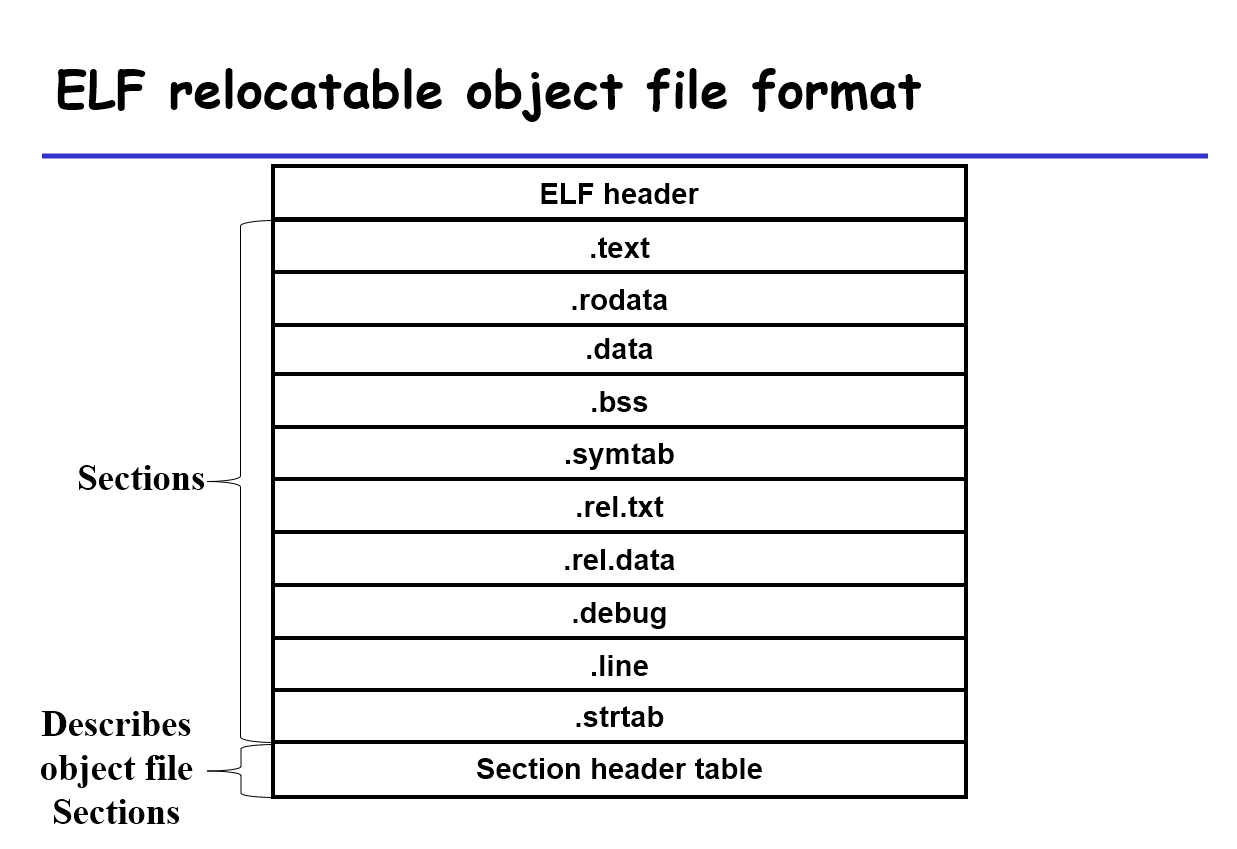
ELF Header
The first part is very important,used to store meta data usually
magic number, type (.o, exec, .so), machine, byte ordering, Beginning of the section header table (as well as the program header table), etc
typedef uint64_t Elf64_Addr;
typedef uint16_t Elf64_Half;
typedef uint64_t Elf64_Off;
typedef int32_t Elf64_Sword;
typedef int64_t Elf64_Sxword;
typedef uint32_t Elf64_Word;
typedef uint64_t Elf64_Lword;
typedef uint64_t Elf64_Xword;
typedef struct{
unsigned char e_ident[16]; /* ELF identification */
Elf64_Half e_type; /* Object file type ET_REL(1)、ET_EXEC(2)、ET_DYN(3)(shared) */
Elf64_Half e_machine; /* Machine type EM_386(3)、EM_IA_64(50)*/
Elf64_Word e_version; /* Object file version */
Elf64_Addr e_entry; /* Entry point address */
Elf64_Off e_phoff; /* Program header offset */
Elf64_Off e_shoff; /* Section header offset */
Elf64_Word e_flags; /* Processor-specific flags */
Elf64_Half e_ehsize; /* ELF header size */
Elf64_Half e_phentsize; /* Size of program header entry */
Elf64_Half e_phnum; /* Number of program header entries */
Elf64_Half e_shentsize; /* Size of section header entry */
Elf64_Half e_shnum; /* Number of section header entries */
Elf64_Half e_shstrndx; /* Section name string table index */
} Elf64_Ehdr;
e_ident[0-3] ‘0x7f’ ‘E’ ‘L’ ‘F’ magic number
e_ident[4] 1(32-bit) / 2(64-bit)
e_ident[5] 1(little) / 2(big)
e_ident[15] size of e_ident[]
typedef struct {
Elf64_Word sh_name; /* Section name (index into the section header string table). */
Elf64_Word sh_type; /* Section type. SHT_PROGBITS、SHT_SYMTAB 、SHT_STRTAB、SHT_REL、SHT_NOBITS
*/
Elf64_Xword sh_flags; /* Section flags. */
Elf64_Addr sh_addr; /* Address in memory image.(If the section will be copied into the memory to execute, this member gives the address at which the section’s first byte should reside
) */
Elf64_Off sh_offset; /* Offset in file. (the byte offset from the beginning of the file to the first byte in the section) */
Elf64_Xword sh_size; /* Size in bytes. */
Elf64_Word sh_link; /* Index of a related section. */
Elf64_Word sh_info; /* Depends on section type. */
Elf64_Xword sh_addralign; /* Alignment in bytes. */
Elf64_Xword sh_entsize; /* Size of each entry in section. (Some sections hold a table of fixed-size entries, this member gives the size in bytes of each entry)*/
} Elf64_Shdr;
ELF String Table
-
Hold null-terminated character sequences (strings)
-
The object file uses these strings to represent symbol and section names
-
One references a string as an index into the string table section

Other Sections
-
debug section: debugging symbol table, local variables and typedefs, global variables, original C source file (gcc -g)
-
.line: Mapping between line numbers in the original C source program and machine code instructions in the .text section.
Sections in ELF obj file
-
.text section: code 代码
-
.rodata section: Read-only data
-
.data section: initialized global and static C variables
-
.bss section (“Block Started by Symbol” or “Better Save Space”)
–uninitialized global and static C variables, along with any global or static variables that are initialized to zero
–has section header but occupies no disk space
–at run time, these variables are allocated in memory with initial value zero
Symbol
-
Defined global symbols
-
Referenced global symbols
-
Local symbols(C functions and global variables with static attribute)
局部非静态变量不是symbol, 不在.symtab段占有空间
Each relocatable object file has a symbol table in .symtab section
Symbol Table包含了:
-
the module(file) that defines the symbol
-
the symbol type (local,global,extern)
-
the section (.text,.data,.bss)
typedef struct {
int name ; /* the name in string table's (byte) offset */
char type:4; /* function or data (4 bits) (usually,还有一些别的)*/
binding:4 ; /* local or global (4 bits) */
char reserved ; /* unused */
short section ; /* section header index */
long value ; /* section offset(for relocatable), or abs address(for executable) */
long size ; /* Object size in bytes */
} Elf64_Symbol ;
**Each symbol is assigned to some section of the object file, denoted by the section field, which is an index into the section header table.**Symbol和某个Section绑定,具体方法是Symbol记录对应Section在Section Header Table之中的index
There are three special pseudosections that don’t have entries in the section header table
-
ABS: symbols that should not be relocated
-
UNDEF: symbols that are referenced in this object module but defined elsewhere
-
COMMON: uninitialized data objects
They only exist only in relocatable object files and do not exist in executable object files
For COMMON symbols
-
value gives the alignment requirement
-
size gives the minimum size
重要:The difference between COMMON and .bss
COMMON:Uninitialized global variables
.bss:Uninitialized static variables, global or static variables that are initialized to zero
重要!!!!!
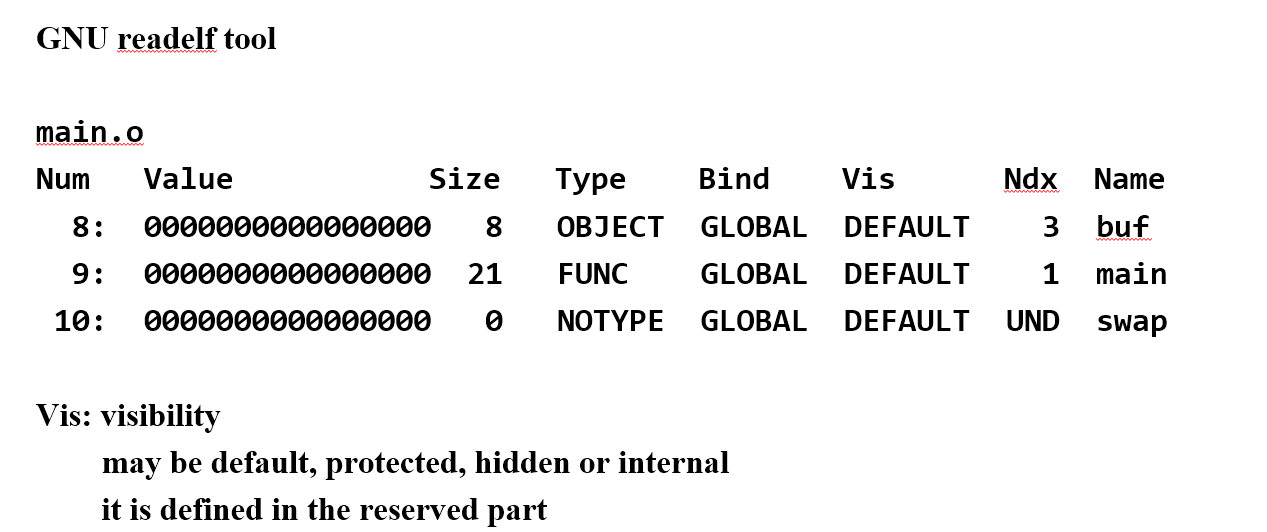
重名问题
强符号: 初始化的全局变量,函数
弱符号: 未初始化的全局
重名:强+强,报错;强+弱,覆盖;弱+弱,任意
静态链接
-
concatenate related relocatable object files into a single file with an index (called an archive, .a)
-
enhance linker so that it tries to resolve unresolved external references by looking for the symbols in one or more archives
-
If an archive member file resolves reference, link into executable
使用静态链接:经典EUD
Scan .o files and .a files in the command line order.
When scan an object file f,
Add f to E
Updates U, D
When scan an archive file f,
Resolve U
If m is used to resolve symbol, m is added to E
Update U, D using m
- If any entries in the unresolved list at end of scan, then error
问题:command line order matters!
原则:总是把链接的库放在最后面,并且可以重复
Relocation
For each reference to an object with unknown location
-
Assembler generates a relocation entry
-
Relocation entries for code are placed in .rel.text
-
Relocation entries for data are placed in .rel.data
例如
09 e8 00 00 00 00 callq e<main+0xe> swap();
/* There is a relocation entry in rel.text */
offset symbol type addend
0a swap R_X86_64_PC32 -4 /* PC32: PC-relative */
.rel.text section
-
relocation info for .text section
-
addresses of instructions that will need to be modified in the merged executable object file
.rel.data section
- relocation info for .data section
- addresses of pointer data that will need to be modified in the merged executable object file
typedef struct {
long offset ;
long type:32 ,
symbol:32 ;
long addend;
} Elf64_Rela ;
int *bufp0 = &buf[0] ;
00000000 <bufp0>:
0: 00 00 00 00 00 00 00 00
/* There is a relocation entry in rel.data */
offset symbol type addend
0 buf R_X86_64_64 0
addend是重定位条目中的一个数值,它在链接时与符号的地址相加,以确定最终的内存地址。这个参数提供了一种机制,允许编译器生成更灵活和可移�植的代码。
Two steps
-
Relocating sections and symbol definitions
-
Relocating symbol references within sections
reloc过程的伪代码:
foreach section s {
foreach relocation entry r {
refptr = s + r.offset ; /* ptr to reference to be relocated */
/* relocate a PC-relative reference */
if (r.type == R_X86_64_PC32) {
refaddr = ADDR(s) + r.offset ; /* ref’s runtime address */
*refptr=(unsigned) (ADDR(r.symbol)+r.addend–refaddr) ;
}
/* relocate an absolute reference */
if ( r.type == R_X86_64_64 || r.type == R_X86_64_32||…)
*refptr = (unsigned) (ADDR(r.symbol) + r.addend) ;
}
}
Executable ELF Object
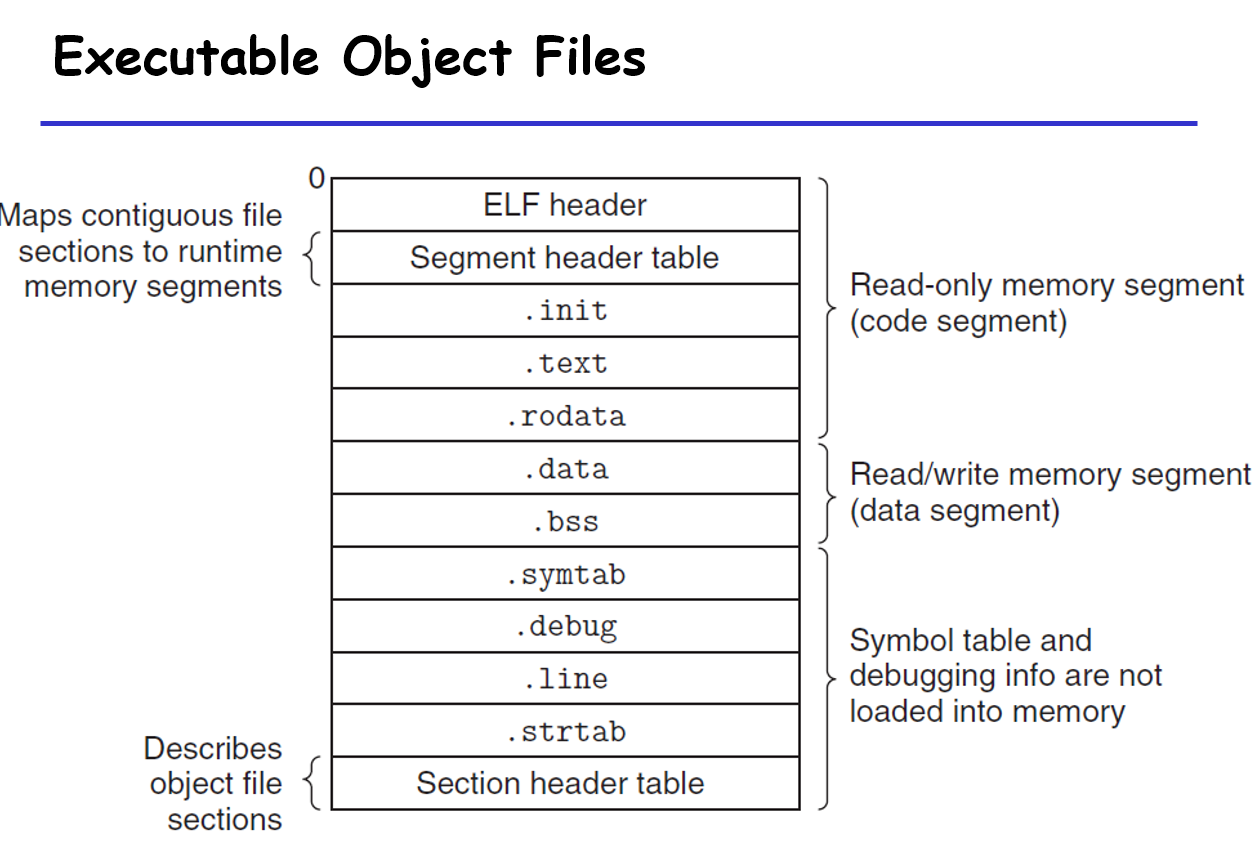
typedef struct{
unsigned char e_ident[16]; /* ELF identification */
Elf64_Half e_type; /* Object file type */
Elf64_Half e_machine; /* Machine type */
Elf64_Word e_version; /* Object file version */
Elf64_Addr e_entry; /* Entry point address */
Elf64_Off e_phoff; /* Program header offset */
Elf64_Off e_shoff; /* Section header offset */
Elf64_Word e_flags; /* Processor-specific flags */
Elf64_Half e_ehsize; /* ELF header size */
Elf64_Half e_phentsize; /* Size of program header entry */
Elf64_Half e_phnum; /* Number of program header entries */
Elf64_Half e_shentsize; /* Size of section header entry */
Elf64_Half e_shnum; /* Number of section header entries */
Elf64_Half e_shstrndx; /* Section name string table index */
} Elf64_Ehdr;
typedef struct {
Elf64_Word p_type; /* Entry type.(PT_LOAD (1): loadable segment) */
Elf64_Word p_flags; /* Access permission flags. Run time permissions (rwx)*/
Elf64_Off p_offset; /* File offset of contents. (Offset from the beginning of the file to the first byte in the segment)*/
Elf64_Addr p_vaddr; /* Virtual address in memory image. (The virtual address of the first byte in the segment)*/
Elf64_Addr p_paddr; /* Physical address (not used). */
Elf64_Xword p_filesz; /* Size of contents in file.Segment size in the object file (>=p_memsz)
*/
Elf64_Xword p_memsz; /* Size of contents in memory. */
Elf64_Xword p_align; /* Alignment in memory and file.Usually 4KB or 2MB*/
} Elf64_Phdr;
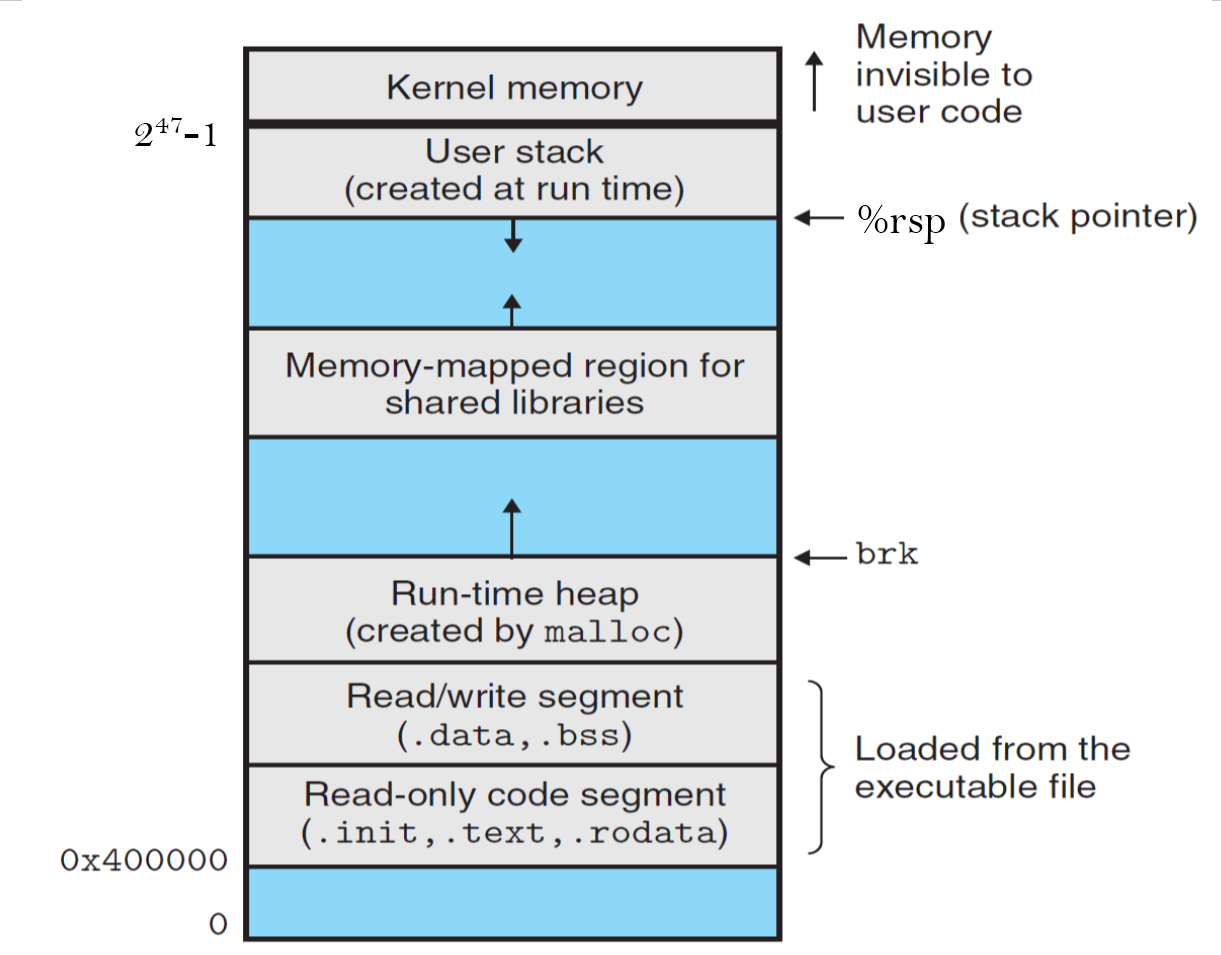
Difference between filesz and memsz means the uninitialized data in .bss
.init section contains a small function _init called by program’s initialization code
startup code
_start: the entry point of the program. Defined in the crt1.o, Same for all C program, Calls system startup function
__libc_start_main: Defined in libc.so, Initializes the execution environment, Calls the main function, Handles return value, Returns control to OS (if necessary)
Loader
Memory-resident operating system code
-
Invoked by call the execve function
-
Copy the code and data in the executable object file from disk into memory
-
Jump to the entry point
-
Run the program
Dynamic Link 动态链接
-
Dynamic Linking
-
Position Independent Code (PIC)
-
Loading and Linking Shared Libraries from applications
静态链接缺点:底层库修改需要所有应用重编译,应用体积过大,冗余代码
Shared Libraries
.so(shared obj) on Linux, .dll(dynamic linking lib) on Windows
gcc –shared –fPIC –o libvector.so addvec.c multvec.c
# –shared: creating a shared object
# –fPIC: creating the position independent code
Partial Linking
在编译时,.so文件没有将.data,.text段等copy,而只是copy了一些relocation and symbol table info
code and data是在memory之中execve() & ld-linux.so链接的
After linking, the locations of the shared libraries are fixed and do not change during the execution time
How to find the ld-linux.so
- The pathname of the ld-linux.so is contained in the .interp segment of p2
上面那张图,memory-mapped region for shared libs
运行时Linking
- Done explicitly by user with dlopen() in Linux
gcc –rdynamic –O2 –o p3 dll.c -ldl
API:
#include <dlfcn.h>
void *dlopen(const char *filename, int flag);
// returns: ptr to handle if OK, NULL on error
void *dlsym(void *handle, char *symbol) ;
// returns: ptr to symbol if OK, NULL on error
int dlclose(void *handle) ;
// returns: 0 if OK, -1 on error
const char dlerror(void) ;
/* returns: errormsg if previous call to
dlopen, dlysym, or dlclose failed,
NULL if previous call was OK */
运行时Linking示例程序
#include <stdio.h>
#include <dlfcn.h>
int x[2] = { 1, 2} ;
int y[2] = { 3, 4} ;
int z[2];
int main()
{
void *handle;
void (*addvec)(int *, int *, int *, int ) ;
char *error;
/*dynamically load the shared library that contains addvec() */
handle = dlopen(“./libvector.so”, RTLD_LAZY) ;
if (!handle) {
fprintf(stderr, “%s\n”, dlerror()) ;
exit(1) ;
}
/*get a pointer to the addvec() function we just loaded */
addvec = dlsym(handle, “addvec”) ;
if ( (error = dlerror()) != NULL ) {
fprintf(stderr, “%s\n”, error) ;
exit(1) ;
}
/* Now we can call addvec() just like any other function */
addvec(x, y, z, 2)
printf(“z=[%d, %d]\n”, z[0], z[1]) ;
/* unload the shared library */
if (dlclose(handle) <0) {
fprintf(stderr, “%s\n”, dlerror()) ;
exit(1) ;
}
return 0 ;
}
用处:
- 分发系统更新,更新dll重新运行时自动加载
- 高性能web server, 对不同的库动态加载卸载,使用缓存来保证函数级别的最小内存占用,也是支持热更新的来源
PIC:位置无关代码
naive: 划分一块区域专门放
actual: 让代码都是PC-relative,从而可以被任意地址加载
- 文件内部函数,变量:简单,直接变成PC-relative
- 文件外部引用,全局变量:间接跳转,以一个Private的.data段开头的GOT(全局偏移量表)作为跳板
调用外部全局变量的解决方案:
-
保证.data段和.text段在加载的时候不分开,一起加载
-
利用1,.data段和.text段现在的距离和加载到的地方没有关系了,在.data段开头的GOT里面记录各个全局的data的offset,然后在.text段记录GOT的entry_index, 访问时 .text -> .data -> GOT[idx] -> global data
GOT 012预留给dynamic linker
调用外部函数的解决方案:PLT(Procedure Linkage Table)
-
在.text段前面加一段plt段,留下外部函数的地址的标记,对地址暂时留空
-
把.text段内部的代码之中所有外部函数的地址该外plt段之中标记的地址(相对地址)
-
当运行时.text->plt-> 如果没有,再加载实际地址到标记留空的地方,之后再次访问不需要实际地址,只需要把plt当跳板就行
PLT:16-byte entry array
PLT[0] 为dynamic linker预留
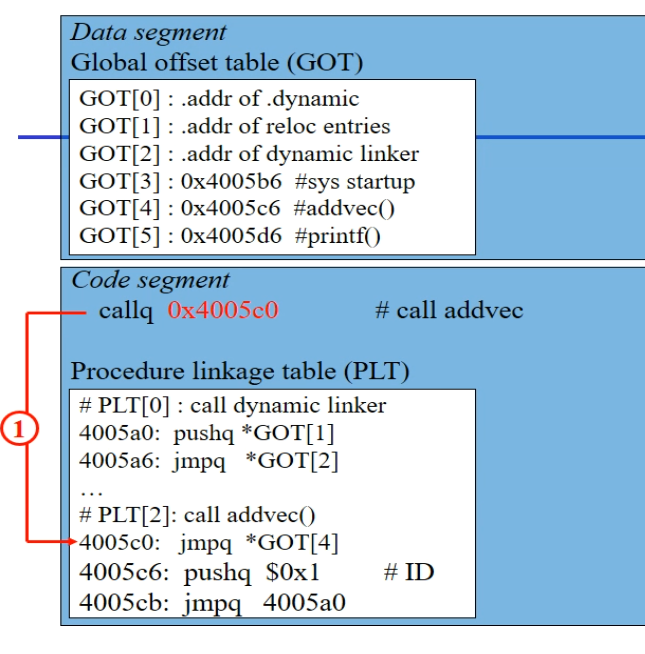
第一次调用addvec
jmpq *GOT[4]发现没有,回来(*GOT[4]存0x4005c6下一条指令的relative,jmp相当于没jmp),pushq $0x1 把addvec的entry ID作为栈上的参数给dynamic linker, 然后jmpq 到PLT[0],PLT[0]压栈*GOT[1]参数后,跳转到dynamic linker,dynamic linker根据*GOT[1]和ID找到对应函数,同时更新GOT[4],填上地址
后面调用addvec都是直接jmpq到*GOT[4],实际上是函数调用
��库打桩
构造“二传手”函数, 截获转发一些已经写好的库函数,例如malloc,可以用于日志,统计等等
编译时打桩:核心在于定义一个自己的同名函数,在自己的函数去调用库函数,例如利用宏定义malloc为mymalloc,再在mymalloc里面去调用系统的malloc
运行时打桩:比较复杂,不太重要
重定向深入
总结: 1. 流水线的设计,使得IP寄存器总是指向下一条指令,计算offset时,需要考虑当前指令的长度 2. 相对偏移如果确定(通常是static data),则以section为基址进行重定向,可以减少符号表大小, Addend = symbol_offset - relocation_len 3. 相对偏移如果不确定,则以symbol为基址进行重定向,Addend = - relocation_len
需要重定向的代码在汇编上以0x0(%rip)给出,%rip是PC,0x0则意味着待填充